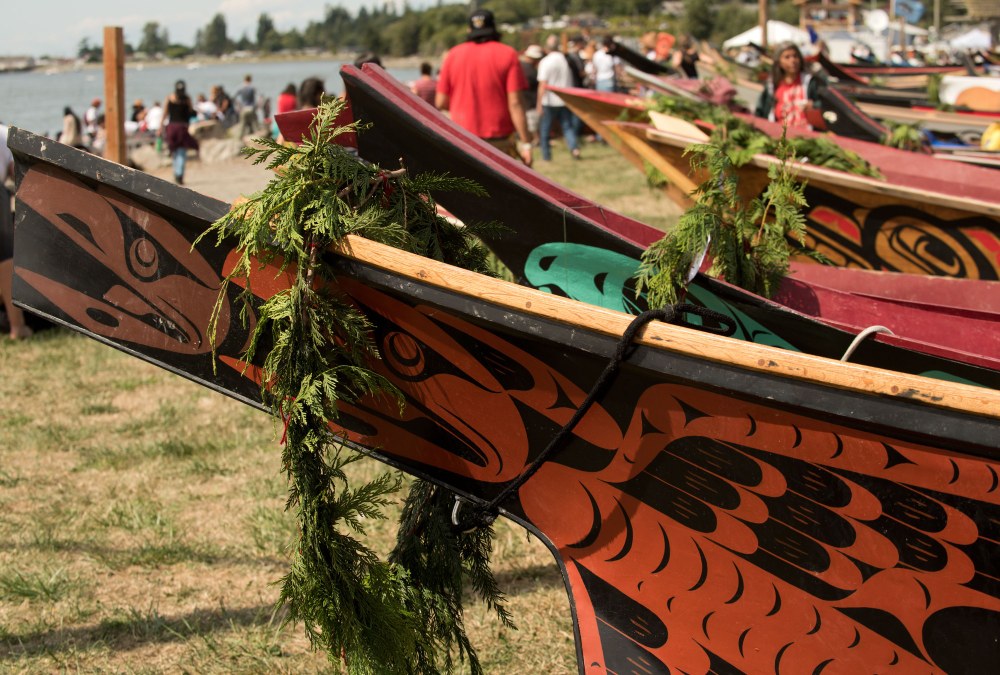
The Mountaineers is partnering with the Sacred Lands Conservancy, an Indigenous-led nonprofit with strong ties to the Lummi Nation, to produce a series of educational pieces on the importance of mindful recreation and how we can all develop deeper connections to the histories of our natural places. Tah-Mahs Ellie Kinley is a Lhaq’temish fisherwoman, an enrolled Lummi Nation tribal member, an elected member of Lummi Nation’s Fisheries and Natural Resource Commission, and President of the Sacred Lands Conservancy (SLC). We hope you enjoy this first blog from her, written in collaboration with SLC’s Julie Trimingham, which unpacks the practice of land acknowledgment and how we can acknowledge the land in a meaningful and impactful way.
- Conor Marshall, Advocacy & Engagement Manager
Acknowledging Indigenous territory is now common practice for events, educational institutions, nonprofit organizations, publications, and others. Such statements can be a good first step toward restoring relations between first peoples and non-Natives, as well as strengthening non-Native connections to the land itself.
Several years ago, The Mountaineers engaged in a process with Leonard Forsman, Chairman of the Suquamish Tribe and President of the Affiliated Tribes of Northwest Indians, to create this organizational land acknowledgment:
The Mountaineers acknowledge that we are on the lands of the Pacific Northwest Indian tribes, who live here and steward these lands and waters as they have since time immemorial. As we pursue our mission, we strive to listen to and amplify Native traditions and values through respectful engagement.
A Brief History of Land Acknowledgments
Knowing the history of land acknowledgments, their significance, and their limitations can help make creating and sharing them truly meaningful.
In Australia, the Aboriginal understanding of the word Country (with a capital C) encompasses the lands and seas, every living thing in the lands and seas, the culture, the language, the people, the history, the spirit, and all the connections among and between everything in and of the place. Traditionally, a Welcome to Country ceremony would be held when one group of Aboriginal people was visiting the territory of another. Welcome to Country ceremonies by definition can only be held by Aboriginal peoples.
The first publicly observed Welcome to Country was held at a festival in the 1970s. Acknowledgments of Country, as offered by non-Aboriginal people, grew out of the reconciliation movement in the 1990s and were inspired by the Welcome to Country ceremonies. The Acknowledgments were, and are, a way for the wider Australian community to engage with Aboriginal and Torres Strait Islander peoples on whose land the country of Australia is located.
Canada is part of the same Commonwealth as Australia, so it may be that the Acknowledgments of Country in Australia found their way to Canada over the years. In 2015, the Canadian government’s Truth and Reconciliation Commission reported that their residential school system had amounted to cultural genocide. Once the horrors of the residential schools and, more broadly, colonization, were more widely understood, land acknowledgments became more widely practiced at sporting events, cultural events, and parliamentary meetings, and were written into the materials of schools and other institutions.
In the United States, land acknowledgments are increasingly given at events and incorporated into the websites and publications of nonprofit organizations, local governments, educational institutions, and cultural spaces.
 Fall/early winter sunrise from Lummi Island. Sun moving south as viewed from the southern part of Lummi Island.
Fall/early winter sunrise from Lummi Island. Sun moving south as viewed from the southern part of Lummi Island.
Land Acknowledgments Can Make a Significant Impact
First the United States tried to erase us, and then history tried to do the same. Despite the deadly diseases brought over with the first waves of Europeans, despite the genocides, the boarding schools, the outlawing of our languages and religions, attempts at assimilation, and policies aimed at destroying tribal sovereignty, Native Americans are still here, and will always be here. However, in books and other media, Native Americans have been and frequently still are referred to in the past tense, as if we no longer exist. Sometimes when we are portrayed, it is often only through the lens of trauma, not resilience and success. Land acknowledgments are a way to fundamentally recognize that we have been here since time immemorial, that we continue to be here, and lovingly steward the places to which we belong.
The specificity of land acknowledgments also serves to teach and/or remind non-Natives that Native Americans are not a single people. There are currently 574 federally recognized Native tribes within the borders of the United States. Many other tribes are not officially recognized. Each tribe is culturally, spiritually, linguistically, socially, governmentally, and/or ethnically unique. It is important to know and to name precisely the peoples (i.e. Lhaq’temish/Lummi and Nooksack) or group of people (i.e. Coast Salish) who belong to a particular city or region (i.e. Bellingham).
Land acknowledgments also point toward the profound connection between Indigenous peoples and the land. This connection can’t quite be captured in English words, because the connection is physical, emotional, cultural, generational, and spiritual. The people and the place cannot be divided from one another.
What Makes for a Good Land Acknowledgment
There are many opinions on what makes for an effective land acknowledgment and whether acknowledgments are effective in the first place. Some common principles include:
- The correct name of the people(s) on whose traditional territory the event is taking place or business is being conducted.
- Acknowledgment that the first peoples of the place still live there (if they do) and that these first peoples have been in a right, reciprocal relationship with the place since time immemorial.
- Acknowledgment of any relevant treaties or agreements by which non-Native people are allowed to be on the land.
- Acknowledgment that a place is not simply a geographical location, but is a complex web of habitats and ecosystems, culture, language, history, and spirit. Truly acknowledging the land requires learning the history of the place, including the history of genocides, displacement, disenfranchisement, poverty, racism, and other violences to which Native Americans have been subjected by the United States government. Truth is the first step toward reconciliation.
- Acknowledging that Native stewardship of the lands was successful for millennia, and that to effectively protect and restore the vitality of the places we call home, we need Native leadership and knowledge.
 A winter sunrise taken from Lummi Island looking south down Hales Passage. Winter sunrises are their most beautiful in the winters of the Pacific Northwest.
A winter sunrise taken from Lummi Island looking south down Hales Passage. Winter sunrises are their most beautiful in the winters of the Pacific Northwest.
A Starting Point for Meaningful Action
A land acknowledgment is a handful of words. If these words are recited because everyone now expects a land acknowledgment, if these words are spoken without knowledge of the Native history of the place, if these words are not followed by meaningful action, then a land acknowledgment is empty. Words that do not mean what they say feel deceitful, which is worse than not saying them at all.
Engage in creating, reading, and sharing land acknowledgments - when the words are informed by what you’ve learned about Native history and the place you’re in, and when the words come from your heart.
Land acknowledgments are best seen as a beginning, as a start to - rather than a replacement for - meaningful action. Such actions can include, but aren’t limited to:
- Upholding treaties
- Strengthening tribal sovereignty
- Supporting Native leadership in politics, the arts, social justice work, and nonprofits
- Supporting policies and politicians who understand and will work for the needs of tribes and tribal members
- Learning and following Indigenous principles for caretaking a place
- Supporting the Land Back movement
Striving for Deeper Connections
It feels good to be respectfully acknowledged. Indigenous people are part of a place, and that place is part of us. We are still here, and we belong where we are. It can feel good to have our fundamental sense of belonging acknowledged.
We hope that the words you read on a plaque, a website, or magazine masthead, or the words that you hear at the beginning of an event, are starting to wake non-Native people up. These words can be a starting point for education, compassion, and action.
Land acknowledgments can also be a starting point for reaching deep inside yourself for your own profound connection to the land upon which you live, work, and play, and the connection to the waters which give you life. You are part of the ecosystem and the place, you are part of the living history. If you wish to be in right, reciprocal relationship with a place and all the life contained therein, acknowledging the truth of that place is a good place to start.
Learn more about how you can take action beyond land acknowledgment in the Conservation Currents article by Tah-Mahs Ellie Kinley and Sacred Lands Conservancy in the September 2023 issue of Mountaineer magazine.
Add a comment
Log in to add comments.Thanks for posting this perspective, highlighting the depth needed for a land acknowledgment to be truly meaningful. And the importance of being in present tense rather than past tense.
 Sacred Lands Conservancy with Tah-Mahs Ellie Kinley
Sacred Lands Conservancy with Tah-Mahs Ellie Kinley